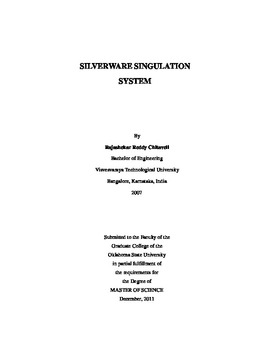| dc.contributor.advisor | Hoberock, Lawrence | |
| dc.contributor.author | Reddy Chitaveli, Rajashekar | |
| dc.date.accessioned | 2014-04-17T19:53:55Z | |
| dc.date.available | 2014-04-17T19:53:55Z | |
| dc.date.issued | 2011-12-01 | |
| dc.identifier.uri | https://hdl.handle.net/11244/10047 | |
| dc.description.abstract | Singulation of silverware, means to `single out' individual pieces of silverware pieces from a mixed batch of silverware, consisting of spoons, soup spoons, knives and forks. The objective of this research is to modify, design, construct and test an efficient automated mechanism to singulate silverware pieces, starting with Akella's (2008) machine. The process of singulation was sub-divided into two stages: 1. Stage-01: Divides the batch of 400 silverware pieces into smaller batches of approximately 20 pieces each, which I accomplished by employing a slow moving conveyor belt, inductive proximity sensors and electromagnets. A mixed batch of silverware pieces is spread on the conveyor belt, which feeds them to a downward inclined plate. The electromagnets beneath the inclined plate holds the silverware pieces to the inclined plate, or releases them, depending on the output signals of inductive proximity sensors, which are also placed beneath the inclined plate. 2. Stage-02: Singulates silverware pieces from these smaller batches. A metering bin collects the silverware pieces from the downward inclined plate. A pulsed solenoid vibrates the metering bin by striking the bin bottom. This causes the silverware pieces to move out through the open end of the bin onto a plastic lined Teflon cloth. This cloth is placed above a moving leather belt carrying a series of hemispherical permanent magnets, such that the silverware pieces attracted by one of the magnets slides along the cloth to exit the machine. An efficient singulating mechanism has been designed and developed. Conveyor feed bin improved the feeding mechanism to deliver silverware pieces to the inclined plate. Inductive proximity sensors were researched, and the sensor beds were designed and developed to provide a reliable feedback to various actuators in the rig. Effectively used plastic lined teflon cloth as a covering material for the moving magnet on the leather belt, which offered improved wear resistance. Singulating efficiency of 97% and throughput of 44 pieces/min were achieved. | |
| dc.format | application/pdf | |
| dc.language | en_US | |
| dc.publisher | Oklahoma State University | |
| dc.rights | Copyright is held by the author who has granted the Oklahoma State University Library the non-exclusive right to share this material in its institutional repository. Contact Digital Library Services at lib-dls@okstate.edu or 405-744-9161 for the permission policy on the use, reproduction or distribution of this material. | |
| dc.title | Silverware Singulation System | |
| dc.type | text | |
| dc.contributor.committeeMember | Hagan, Martin | |
| dc.contributor.committeeMember | Delahoussaye, Ronald D. | |
| osu.filename | ReddyChitaveli_okstate_0664M_11809.pdf | |
| osu.college | Engineering, Architecture, and Technology | |
| osu.accesstype | Open Access | |
| dc.description.department | Mechanical & Aerospace Engineering | |
| dc.type.genre | Thesis | |
| dc.subject.keywords | alignment | |
| dc.subject.keywords | separation | |
| dc.subject.keywords | silverware | |
| dc.subject.keywords | singulation | |
| dc.subject.keywords | sorting | |
